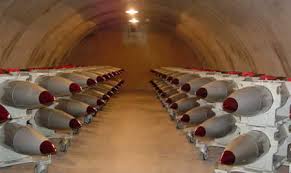The New York Times recently ran an excellent story on the administration’s ambitious plan for the future of the U.S. nuclear arsenal, which includes building new generations of nuclear-armed bombers, missiles, and submarines. But I want to discuss an important issue that the article didn’t mention: The United States also intends to develop and produce new types of nuclear warheads rather than simply refurbishing existing warheads as they age. There are both technical and political reasons why this is a bad idea.
New nuclear warheads may be less reliable—and lead to resumed nuclear testing
On the technical side, the military may have less confidence in the performance of these new warheads than those they replace.

B61 bombs in storage. (Source: US Govt.)
Until 1992, the United States conducted nuclear explosive “proof” tests to verify that its new warhead designs would work as intended. Since then, the United States has observed an international moratorium on nuclear explosive testing and in 1996 signed the Comprehensive Test Ban Treaty (CTBT) banning such tests. The CTBT is an important barrier to nuclear weapons development by more nations.
In the past two decades, the United States has not produced or deployed any new warheads. Instead it has refurbished existing warheads by replacing aging components with new ones.
But the administration now plans a change in course. It will develop new warheads by using components from existing warheads, but in combinations that have never been proof tested. Confidence in the performance of these weapons will instead be based on experimental data from other types of tests and computer simulations. This approach could raise serious questions about the reliability of the U.S. arsenal—and lead to calls for resumed nuclear explosive testing. And a future administration might decide to do just that. If the United States resumed testing, other nuclear nations would likely follow suite and the CTBT would unravel.
New nuclear warheads would undercut non-proliferation goals
On the political side, this new approach flies in the face of President Obama’s promise not to develop new types of warheads. His 2010 Nuclear Posture Review flatly states that “The United States will not develop new nuclear warheads,” noting that the United States “can ensure a safe, secure, and effective deterrent without the development of new nuclear warheads or further nuclear testing.”
Some argue that current plans do not violate this promise. They say that these new warheads are not truly new because they will use components from existing warheads, but this is semantic shenanigans. A warhead that has never existed before is new.
Why did Obama make this pledge? To demonstrate that the United States intends to make good on its commitment as a nuclear weapons state under the Nuclear Non-Proliferation Treaty (NPT) to move toward eliminating nuclear weapons, and hence strengthen the NPT regime. The 178 NPT signatories that have forsworn nuclear weapons in return for this commitment from the nuclear weapons states undoubtedly take this pledge seriously.
If the United States proceeds to build new nuclear weapons, it will undermine the NPT regime and make a mockery of the CTBT, which was intended to prevent the development of new nuclear weapons. The United States is one of the greatest beneficiaries of these treaties, which help keep other states from building nuclear weapons.
A better approach
Rather than going down this path, the United States should simply refurbish (or, in some cases, retire) existing warheads as needed, continuing past practice. This will preclude concerns about the reliability of new types of warheads, and be consistent with President Obama’s pledge not to develop new nuclear warheads.
